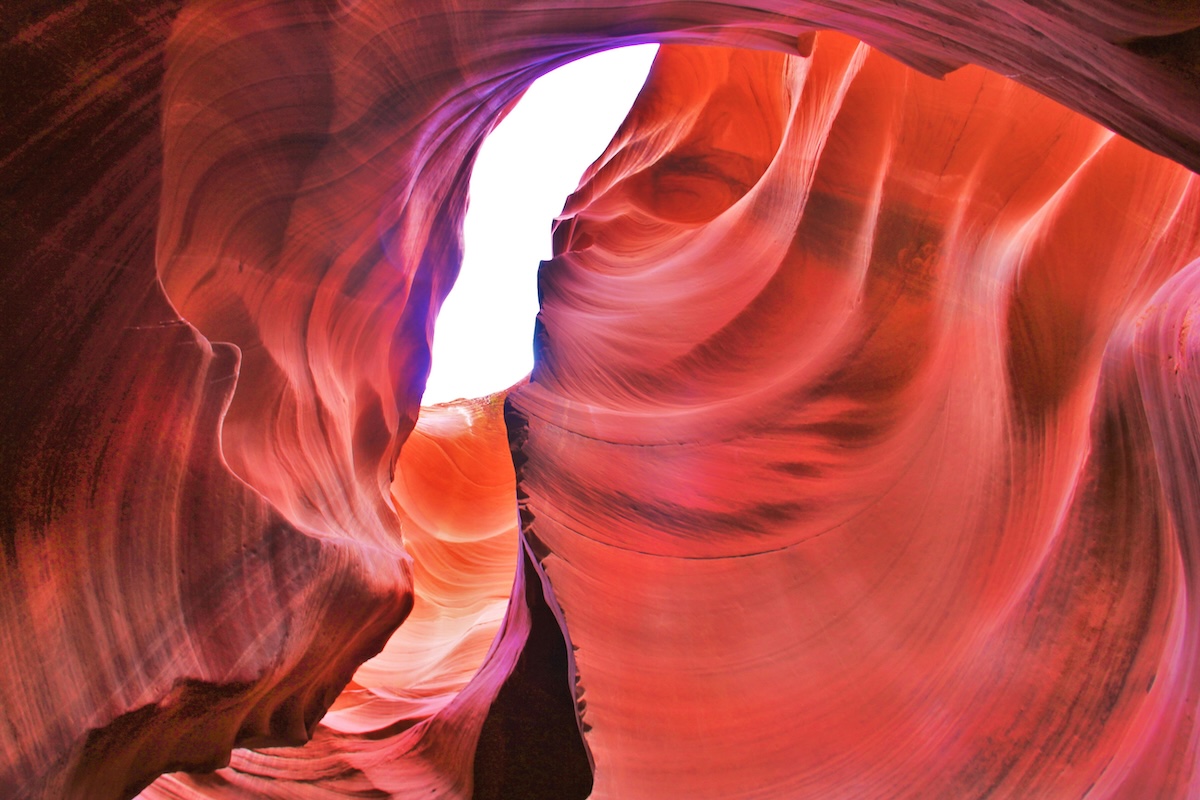
Antelope Canyon: The Hidden Spot in Arizona That Glows in Neon Colors with No Artificial Light
By: Mike Coleman
Skip to Section
You’ll find one of nature’s most spectacular light shows in northern Arizona’s Navajo Nation. With its smooth, flowing sandstone walls, Antelope Canyon’s dazzling display of color and light seems artificial, but this kaleidoscopic display happens without a single artificial light source—just sunbeams, sandstone, and perfect timing.
The slot canyon’s walls light up in shades of orange, pink, purple, and gold that shift throughout the day, creating light beams or light shafts when conditions align perfectly. These natural spotlights pierce through the darkness of the canyon, creating an otherworldly glow that draws thousands of visitors each year.
But how exactly does this natural light show happen? Let’s take a look!
How Antelope Canyon Formed
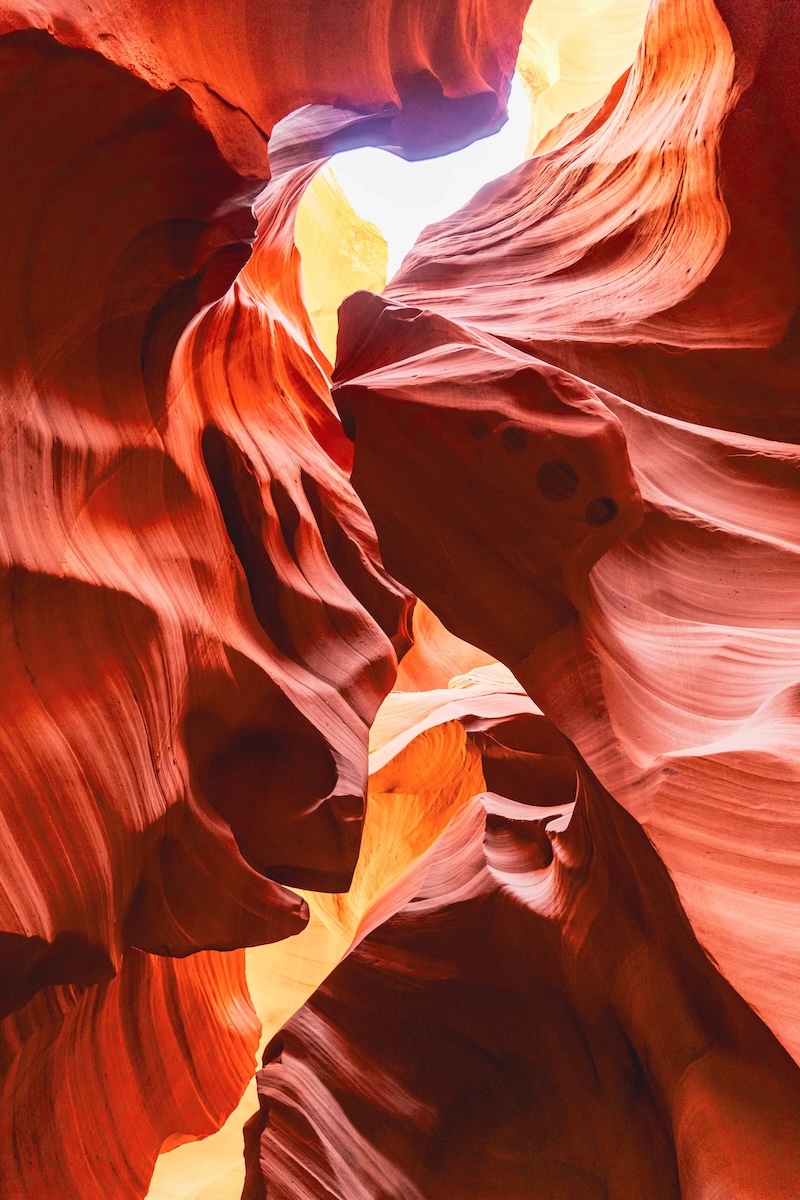
Photo by Ram Access on Unsplash
Antelope Canyon formed through a process that took millions of years. The canyon consists of Navajo Sandstone, a geological formation dating back to the Jurassic period, roughly 190 million years ago. This sandstone began as dunes in an ancient desert, which eventually compressed into stone.
The canyon itself formed through flash flooding. During Arizona’s monsoon season, rainwater collects in the basin above the canyon. This water picks up speed and sand as it rushes toward the Colorado River, flowing through small cracks in the sandstone. Over thousands and thousands of years, these seasonal floods carved out the smooth, flowing shapes that make Antelope Canyon so distinctive.
The canyon comes in two sections:
- Upper Antelope Canyon (Tsé bighánílíní in Navajo, meaning “the place where water runs through rocks”)
- Lower Antelope Canyon (Hazdistazí in Navajo, meaning “spiral rock arches”)
Each section has its own character, with Upper Antelope featuring the famous light beams and Lower Antelope offering spiral rock formations and a more rugged hiking experience.
How Antelope Canyon Glows
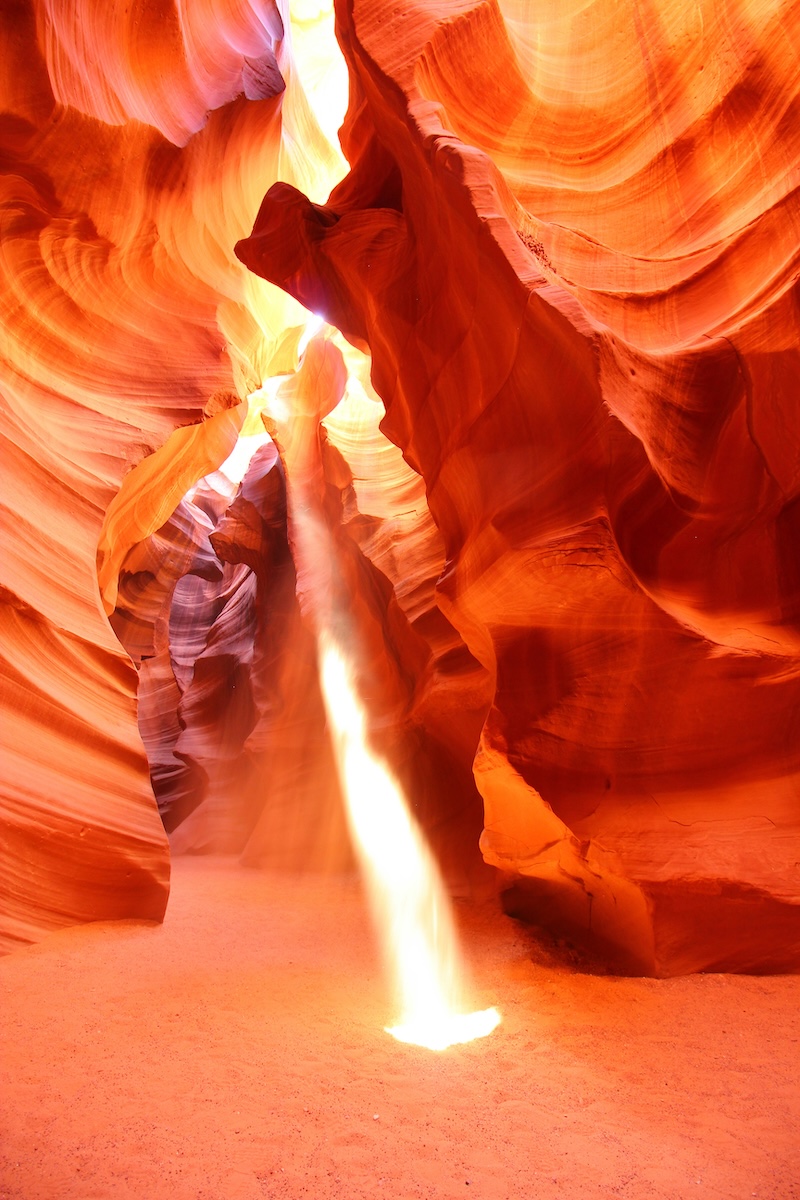
Photo by Florian Wehde on Unsplash
The neon glow of Antelope Canyon relies on several physical phenomena working together:
1. Reflected Light
The canyon’s famous glow comes primarily from light that bounces between the sandstone walls. When sunlight enters the narrow opening at the top of the canyon, it reflects off one wall, then another, and so on. Each reflection picks up the reddish-orange color of the sandstone, growing more saturated with each bounce. This process creates the rich colors that seem to radiate from within the rock.
2. Light Scattering
As sunlight travels through the tiny particles of dust floating in the canyon, it scatters in a phenomenon known as the Tyndall effect. This scattering makes the light beams visible as distinct columns cutting through the darkness, similar to how sunbeams become visible through clouds or trees.
3. Color Absorption and Reflection
The sandstone walls contain iron oxide (rust) and other minerals that absorb certain wavelengths of light while reflecting others. The iron oxide reflects primarily red, orange, and yellow wavelengths, giving the canyon its warm glow. Other minerals in the rock can reflect purples, blues, and greens in certain areas.
4. Angle of the Sun
The most dramatic light shows happen when the sun sits directly overhead, allowing light to penetrate deep into the canyon. This perfect alignment happens only during specific months and times of day, making the famous light beams a seasonal phenomenon.
When to See the Lights in Antelope Canyon
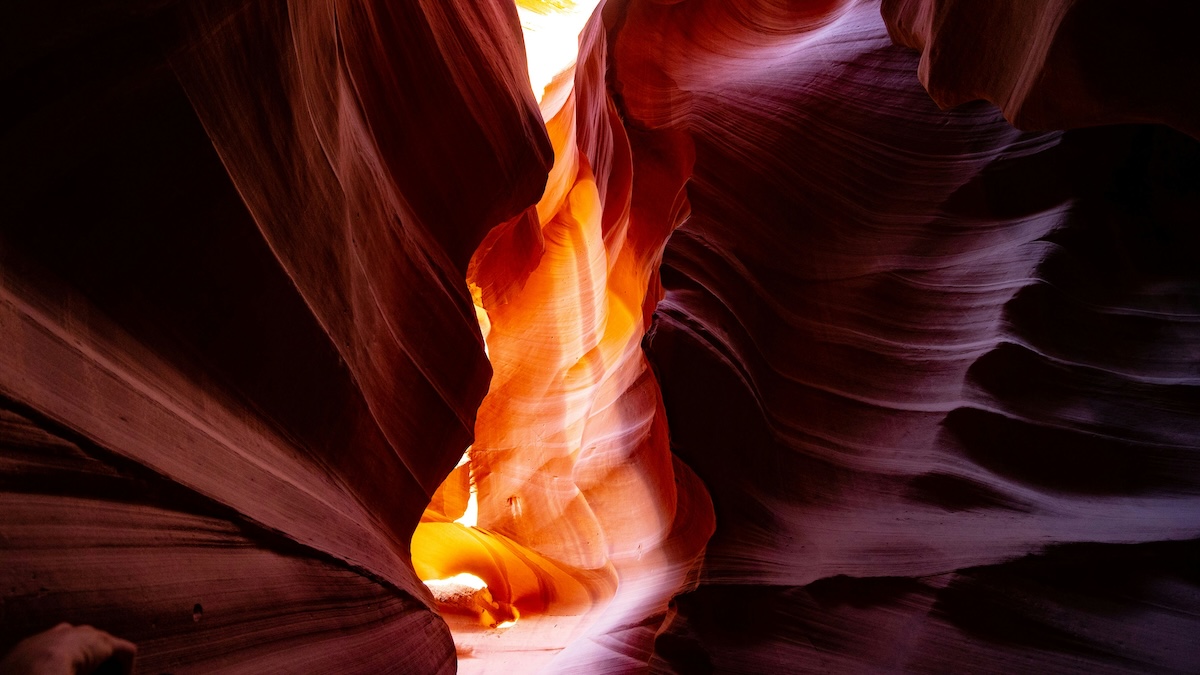
Photo by Tom Gainor on Unsplash
The light beams in Upper Antelope Canyon appear most consistently from late March through early October, with peak viewing from mid-April through mid-August. During this period, the sun reaches the right angle to create beams around midday, typically between 11 AM and 1:30 PM.
Lower Antelope Canyon doesn’t produce the same dramatic light beams but offers more consistent lighting throughout the year. The best times to visit for photography are typically early morning or late afternoon when the light bounces more dramatically off the curved walls.
Several factors can affect the quality of the light show on any given day:
- Cloud cover can block the direct sunlight needed for the most vivid colors
- Dust in the air can enhance or diminish the visibility of light beams
- Recent rainfall can change the color of the sandstone temporarily
- The time of year affects the angle of the sun and the depth the light can reach
Why Antelope Canyon Looks Neon
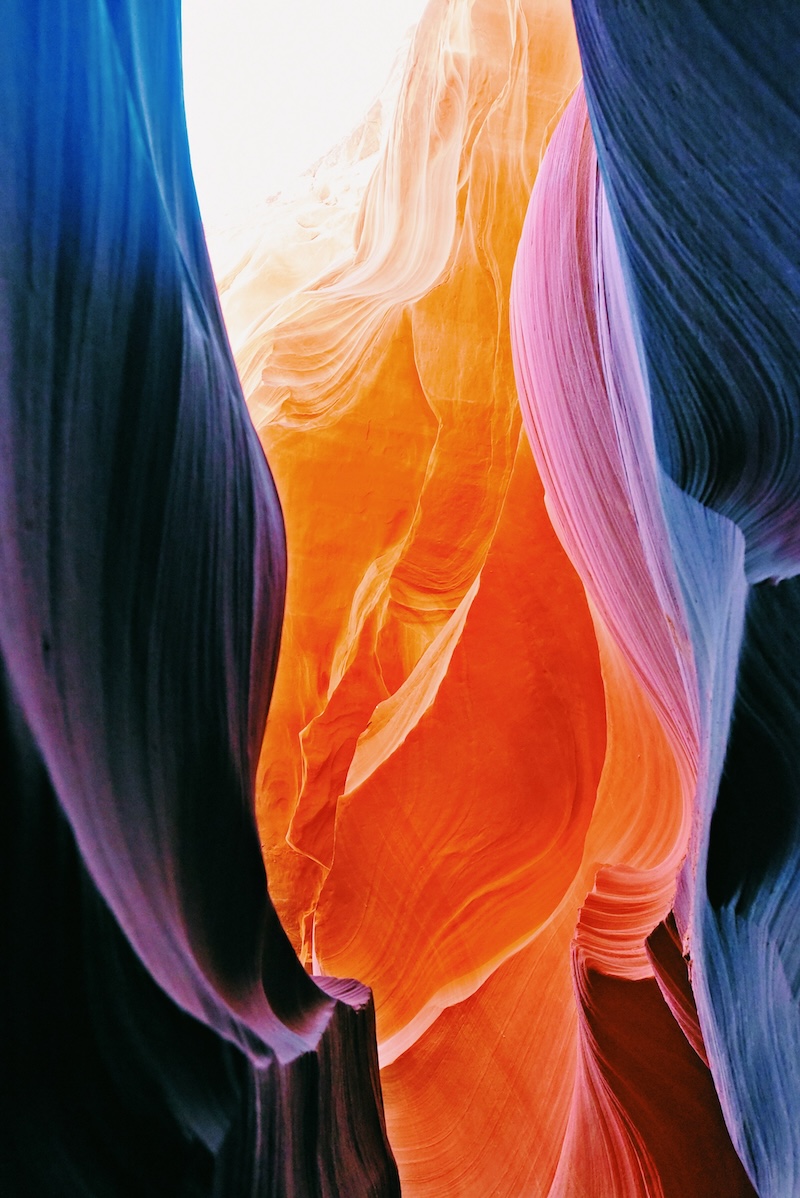
Photo by tommao wang on Unsplash
The almost fluorescent quality of Antelope Canyon’s colors comes from a phenomenon called color saturation. As light bounces between the reddish-orange walls, each reflection strips away more of the blue and green wavelengths while amplifying the reds, oranges, and yellows.
This creates a color purity rarely seen in nature. The human eye perceives these highly saturated colors as especially vivid or “neon,” particularly when they contrast with the deep shadows of the canyon.
The canyon walls also contain varying amounts of minerals that create different color effects:
- Iron oxide creates the dominant reds and oranges
- Manganese oxide contributes purples and blues
- Limonite adds yellow tones
- Copper compounds can create greenish hues in some areas
When sunlight hits these mineral deposits at just the right angle, the colors pop with an intensity that often looks enhanced in photographs—though the effect appears just as vivid to the naked eye.
Photography Challenges in Antelope Canyon
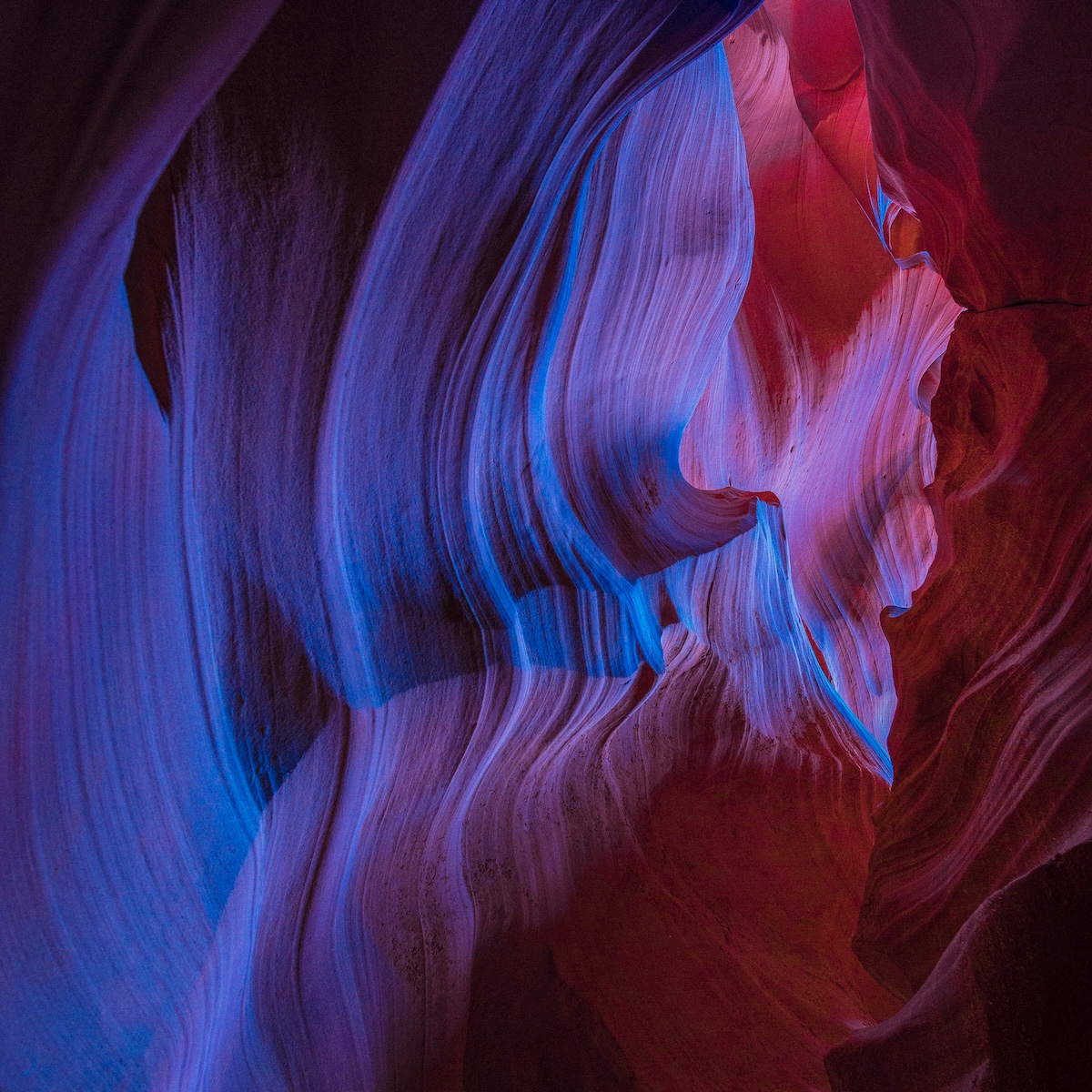
Photo by Daniel Olah on Unsplash
Photographers face unique challenges when trying to capture Antelope Canyon’s famous light. The extreme contrast between the bright light beams and dark canyon walls exceeds what most cameras can record in a single exposure.
Professional photographers often use techniques like:
- HDR (High Dynamic Range) photography, combining multiple exposures
- Spot metering to properly expose the light beams
- Waiting for dust to settle or asking guides to throw dust into the air to make beams more visible
- Using tripods to stabilize cameras in low-light conditions
Even with advanced techniques, many photographers note that pictures rarely capture the true experience of standing inside the canyon as the light shifts and changes, creating an almost living quality to the colors.
The Navajo Connection to Antelope Canyon
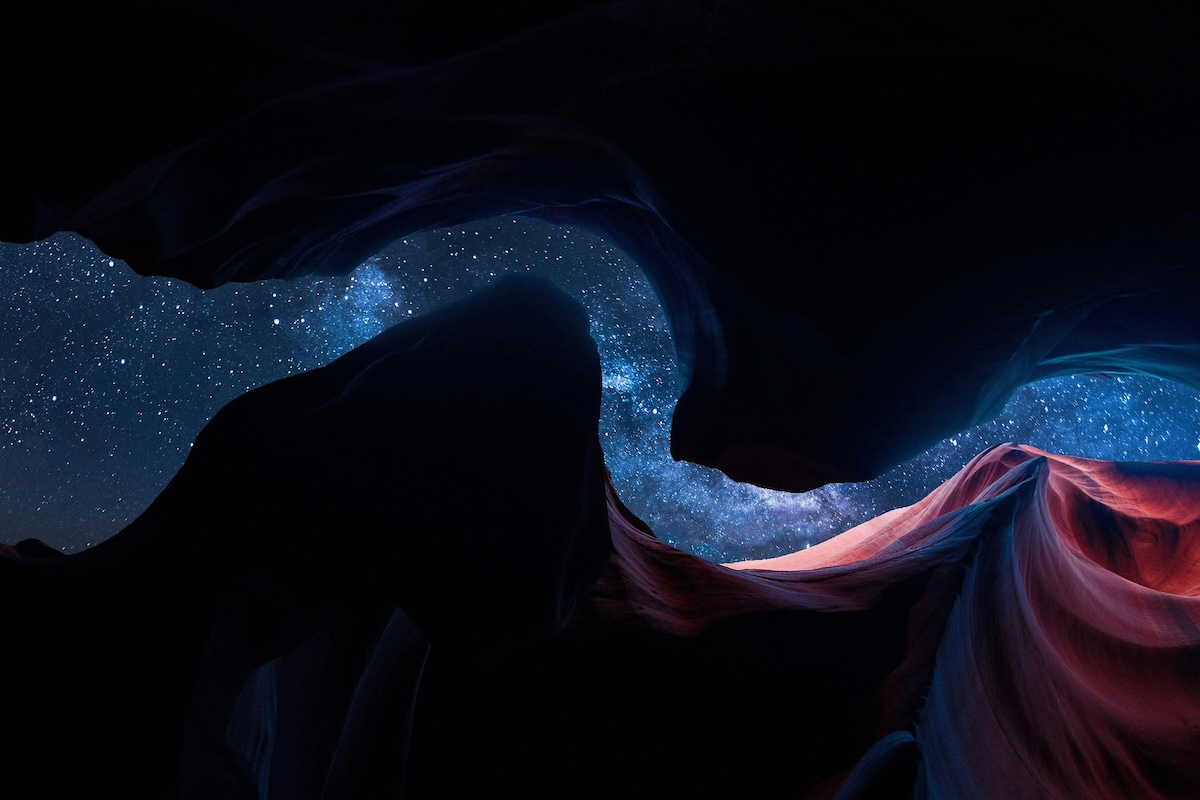
Photo by Ameer Basheer on Unsplash
For the Navajo Nation, which manages and protects Antelope Canyon, the site holds cultural and spiritual significance beyond its photographic appeal. The play of light and shadow through the canyon represents the movement of spirits through the natural world.
The Navajo name for Upper Antelope Canyon, “Tsé bighánílíní” (the place where water runs through rocks), connects to traditional stories about the relationship between water, stone, and light. Navajo guides often share aspects of this cultural knowledge with visitors, adding depth to the experience beyond the visual spectacle.
All tours of Antelope Canyon require Navajo guides, providing economic opportunities for the local community while ensuring the preservation of both the physical site and its cultural context.
The popularity of Antelope Canyon has led to concerns about preservation. The soft sandstone walls can be damaged by touching, and increased foot traffic alters the canyon floor. To protect this natural wonder, the Navajo Nation has implemented strict visitor policies:
- All visits require permits and official guides
- Photography tours are limited and separately ticketed
- Physical contact with the canyon walls is prohibited
- Visitor numbers are capped daily
These measures help maintain the delicate ecosystem that creates the light show and protects the canyon walls.
Similar Natural Light Phenomena Around the World
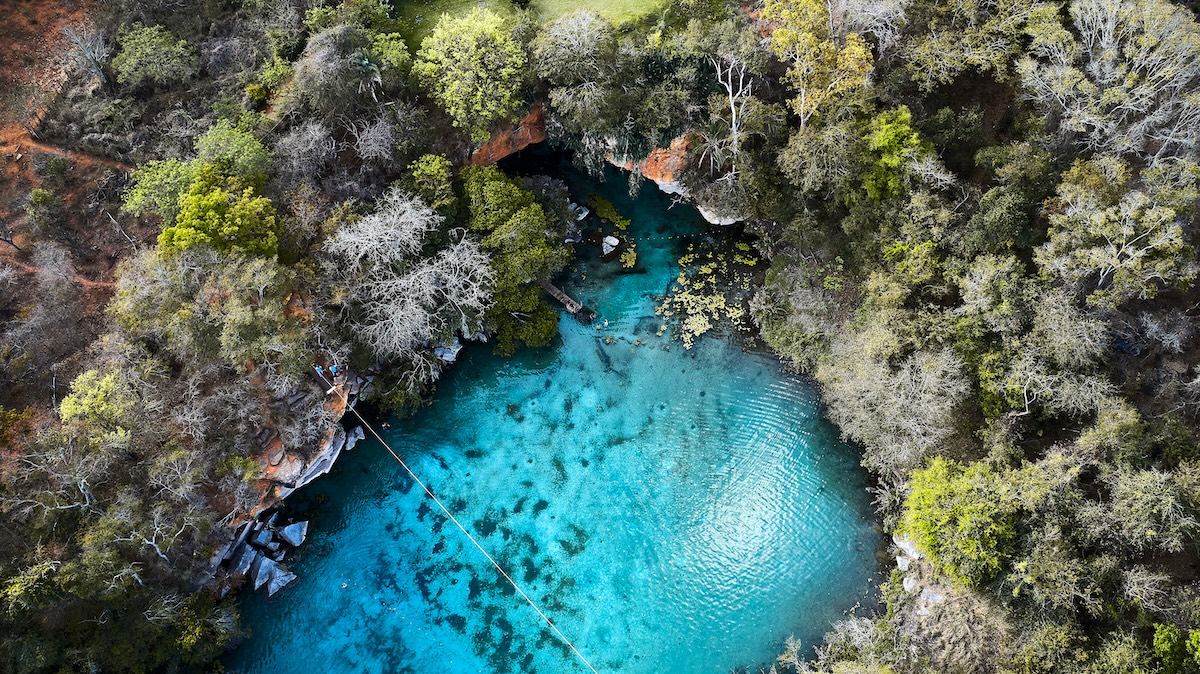
Photo by Felipe Dias on Unsplash
While Antelope Canyon may be the most famous example of this natural light phenomenon, similar effects occur in other slot canyons and cave systems worldwide:
- Canyon X and Rattlesnake Canyon nearby in Arizona display similar light effects with fewer crowds
- The Wave in Arizona / Utah creates colorful light patterns across its curved sandstone surface
- Chapada Diamantina in Brazil features caves with blue light created by water reflection
- Melissani Cave in Greece glows bright blue when sunlight hits its underground lake
- Reed Flute Cave in China shows natural color variations in its limestone formations
What makes Antelope Canyon special among these sites is the combination of its narrow openings, the specific mineral composition of its walls, and the perfect alignment with the sun’s path that creates those famous light beams.
For those lucky enough to witness it, the glow of Antelope Canyon offers a reminder of how ordinary elements—sunlight, stone, and time—can combine to create something extraordinary.
Have you been to Antelope Canyon, or another place that seems totally out of this world? Share your stories and advice with the Frayed Passport community!
About the Author
Mike is a writer who researches and shares actionable advice around travel lifestyle, finance, and personal growth. He loves any trip where he can explore the great outdoors, and believes everyone should be able to experience travel for personal development and fulfillment. Read his other articles on Frayed Passport here.Featured image by Justin Wang on Unsplash
Information published on this website and across our networks can change over time. Stories and recommendations reflect the subjective opinions of our writers. You should consult multiple sources to ensure you have the most current, safe, and correct details for your own research and plans.
Frayed Passport is a participant in the Amazon Associates Program, an affiliate advertising program designed to provide a means for sites to earn advertising fees by advertising and linking to Amazon.com. We also may share links to other affiliates and sponsors in articles across our website.




